vgthought.com
Platformer of the Month 3: Metal Storm
Posted: 2014-04-27 11:00:31
Last edited: 2014-04-28 17:00:52
Last edited: 2014-04-28 17:00:52
This was originally posted on July 1st, 2011.
Admittedly, these are some pretty shallow comments. All I've done is identify the most noticeable feature of each stage and note that the boss also has that feature. I'm not sure this writeup has much of a point, but it at least introduces the idea that action can follow some relevant core.
Admittedly, these are some pretty shallow comments. All I've done is identify the most noticeable feature of each stage and note that the boss also has that feature. I'm not sure this writeup has much of a point, but it at least introduces the idea that action can follow some relevant core.
Games discussed:
Metal Storm
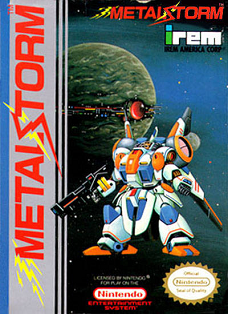
Metal Storm
NES - 1991
Developer: Irem
For those of you not in the know, Metal Storm features a mech which can reverse gravity at will. This ability lets you walk on the ceiling or on the floor as you please. Though it is required only occasionally, it is often helpful for navigating on platforms and around enemies. Your mech--the M-308 Gunner--comes equipped with a rapid fire laser machine gun type device, which may be fired up, down, and forward. (Try to shoot backwards and youíll turn around.) Enemy AI is pretty simple, often relying on the stageís structure to provide challenge. Each stageís structure has a unique gimmick to it: the looping stage, the elevator stage, so on and so forth.
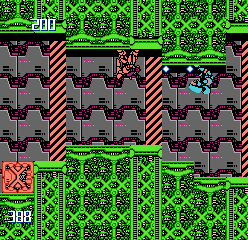
Here you can see the M-308 Gunner, an orange mech, standing on the ceiling.
Itís interesting to note that, in an abstract sense, Metal Storm plays much like Iremís best-known effort, R-Type. Both games are about finding the safe spaces to occupyóitís a matter of outwitting enemies more than outmaneuvering them, though the latter certainly comes into play to an extent. Tackling Metal Storm or R-Type is easy after youíve figured out what to do. You wonít need (very) fast reflexes to get through either one.
Amongst those who have played it, Metal Storm is almost universally beloved. Back in the day, Nintendo Power even gave it a lengthy feature in issue #22; however, the game just wasnít meant for fame, and Metal Storm remains obscure today. Even the internet has only afforded Metal Storm a small measure of popularity. For instance, the Happy Video Game Nerd praised it in his inaugural episode. On the other hand, the Video Game Critic, a lone voice of dissent, gave it quite a thrashing.
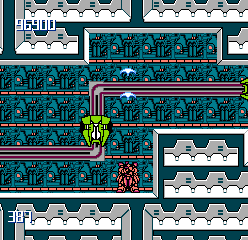
The game is fun, but man, these graphics are messy. This game seriously needs a higher resolution and more colors.
Like in many platformers, each stage of Metal Storm is filled with numerous platforms and simple-minded enemies. Boss encounters at the end of stages provide a satisfying contrast: each one is a single enemy with relatively complex AI in a room with few, if any, platforms. Each stage is a sequence of small challenges (enemies and platforms) leading up to one big challenge (the boss).
In addition, shouldnít a boss be relevant to its stage or world? In platformers, many a stage is built around a certain theme expressed in its elements. For instance, in Mega Man 3, Magnet Manís stage contains magnets which pull Mega Man; theyíre a unique element which give that stage a certain feel no other stage has. And, to match, Magnet Man himself has a move which pulls Mega Man with a magnet. If a stageís elements all contribute to its theme, and a boss is just the last element of a stage, shouldnít the boss also be relevant to that stage's theme?
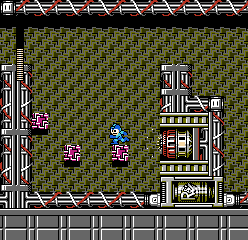
Here, a magnet tries to yank Mega Man off of a block. Lay off, magnet!
In Metal Storm, some bosses take after their stages quite visibly. The second stage is unique because it loops from top to bottom, similar to the downward sliding portions of Sonic the Hedgehog's Labyrinth Zone. In stage 2, if you fall off the bottom of the stage, you land at the top of the stage; however, the camera follows you, making the stage appear to be infinitely tall. The boss takes after this gimmick, since it also loops vertically. During the boss fight, you can leap up or down as much as you want, and the screen will loop. Hereís a video of how that works.
The fourth stage boss is another good example. For the entire fourth stage, your M-308 Gunner is stuck within a box as it scrolls through the stage, letting many enemies inside the box. The Gunner is also stuck inside that box for the boss fight. During the boss fight and during the stage, there are enemies both outside and inside the box.
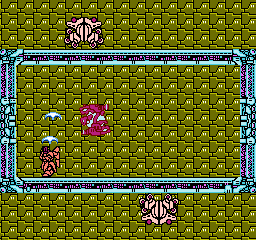
During the fourth boss, your M-308 Gunner is stuck inside a pale blue box with that weird pink and blue creature. Two pale robots shoot lasers from outside of the box--one above, one below.
Also, the third stage features enemies which move along a single track running through the entire stage. Because you can see the track, you can see exactly where enemies will be.
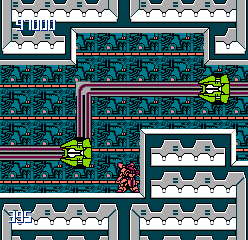
These green enemies move along the gray-and-maroon tracks.
The boss does not move on a predetermined path, instead following your Gunner to whatever quadrant of the screen it goes. However, the quadrants of the screen are separated by regularly fired lasers which move in a regular pattern; one series of lasers divides the screen in half vertically, and the other divides the screen in half horizontally. Weaving between these lasers is similar to taking on the track-based enemies of the stage; both the enemies and the lasers move along a fixed path at a fixed speed.
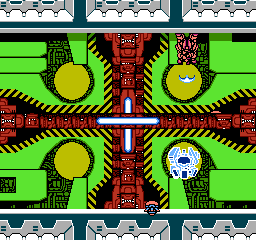
Blue and white lasers are fired along the red cross in the background. The lasers move on a fixed path in regular intervals, just like the green enemies in the stage proper.
However, the bosses arenít perfect matches.
The second boss may more appropriately fit the fifth stage. The fifth stage is overrun with enemies that fire lasers straight ahead in regular intervals across the entire screen at insane speeds. Itís very obvious when and where the lasers will fire; the trick is getting around the huge lasers and taking out the enemies that fire them. The second boss consists of enemies that do just this: they fire large lasers straight across the screen, they provide a very visible tell before they fire a laser, and the lasers they fire are fast.
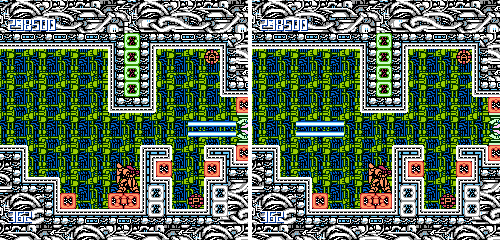
See that green thing on the far right? It fires blue lasers that stretch across the entire screen almost instantaneously. These two images are only two frames apart.
The fifth boss itself, on the other hand, is a reversal of the enemies that populate the fifth stage. It fires tiny lasers which are small and (relatively) slow. In addition, most of the lasers in this boss fight donít move on a straight path, instead opting to either curve once they see your Gunner or bounce off the floor and ceiling. Youíre given plenty of time and space to avoid the lasers, the only problem being that there are quite a few of them.
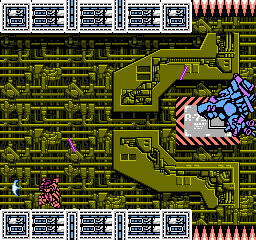
Can you make out those tiny pink lines? Those are slow moving reflective lasers courtesy of the fifth boss.
The sixth boss is also a reversal of sorts. The sixth stage loops top to bottom, though the camera does not follow you vertically; you loop from top to bottom in the same way that you loop from left to right in Mario Bros. or Kid Icarus. If you are on top of a platform, you can reverse gravity to land on its underside, and vice versa. This technique is well-nigh required to get through the sixth stage, since enemies will mount themselves above and below platforms, often requiring you to stand on the opposite side of a platform.
The boss, on the other hand, becomes convoluted if you so much as think about the ability to reverse gravity. Thereís no great way to explain it in words, so Iíve recorded a video to show you what I mean.
The first boss is a simple, immobile thing that shows off weak points on different sides. I think of it as a tutorial boss; itís fitting for the first stage, which is largely a tutorial stage.
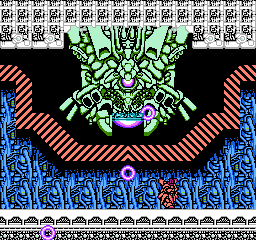
Big, but not very impressive.
The final boss is even simpler, with no offensive capabilities and no attempts to hide its weak points. It comes after a boss rush containing every other boss in the game; I like the concept that, having beaten every boss in a row, youíve mastered everything the game has to throw at you. The ease of the final boss is affirmation of this. I'll admit, though, it certainly seems cheap on the developers' end.
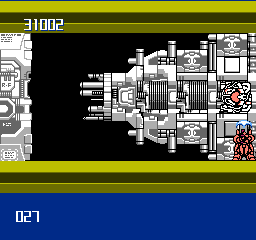
Sit on the far right and fire upward, and you'll finish off the final boss in no time... on normal difficulty.
And thatís all the bosses, aside from one miniboss in the fourth stage. What can I say? Itís a short game.
I can't say Metal Storm bosses are strictly loyal to their stages, but they come close. Even the fifth and sixth bosses are nice, providing an almost appropriate contrast to their stages. Metal Storm is a simple game with simple bosses, making it an easy introduction to studying boss design. Donít get me wrong, though, weíre not talking Super Mario World simple here; these bosses arenít throwaways. There is something here to grasp, even if itís not complex.
Postscript
This line of questioning makes a mess of Mega Man bosses. Take, for instance, Wood Man from Mega Man 2. His stage is largely defined by its enemies. Among these are dogs that shoot fire in a downward arc, roosters that run haphazardly into Mega Man, and gorillas that leap at Mega Man from below. Wood Man's attack pattern is as follows: drop damaging leaves from the ceiling, throw a leaf shield at Mega Man, jump at Mega Man. If you see the relation between the enemies and the boss, youíre more perceptive than I am.
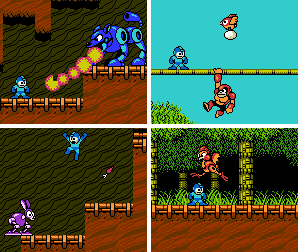
Wood Man's cronies...
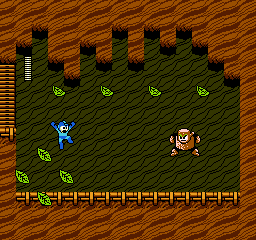
...and Wood Man himself.
Gravity Man from Mega Man 5 is arguably the most relevant robot master out of the entire series. His entire attack pattern consists of reversing gravity in an attempt to collide with or shoot Mega Man; this is also how his stage tries to kill Mega Man. Gravity Man is also on the boring end of Mega Man bosses, with a simple attack pattern that fails to challenge; it doesnít seem like mere relevance--or, at least, this interpretation of "relevance"--is enough to make a compelling boss. Perhaps a boss can be relevant to a stage in more subtle, interesting, and meaningful ways than just copying the stageís elements.
Before I go, remember the giant ship that made the third stage of R-Type? That giant ship cameos three times in the background of the sixth boss of Metal Storm.
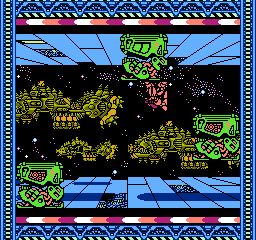
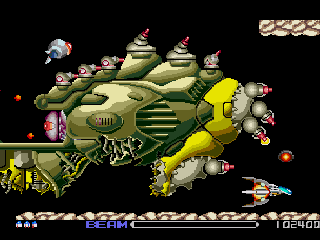
Above, an awesome platformer. Below, an awesome shmup.
comments powered by Disqus
All original content on VG Thought was written by Greg Livingston AKA Golem.